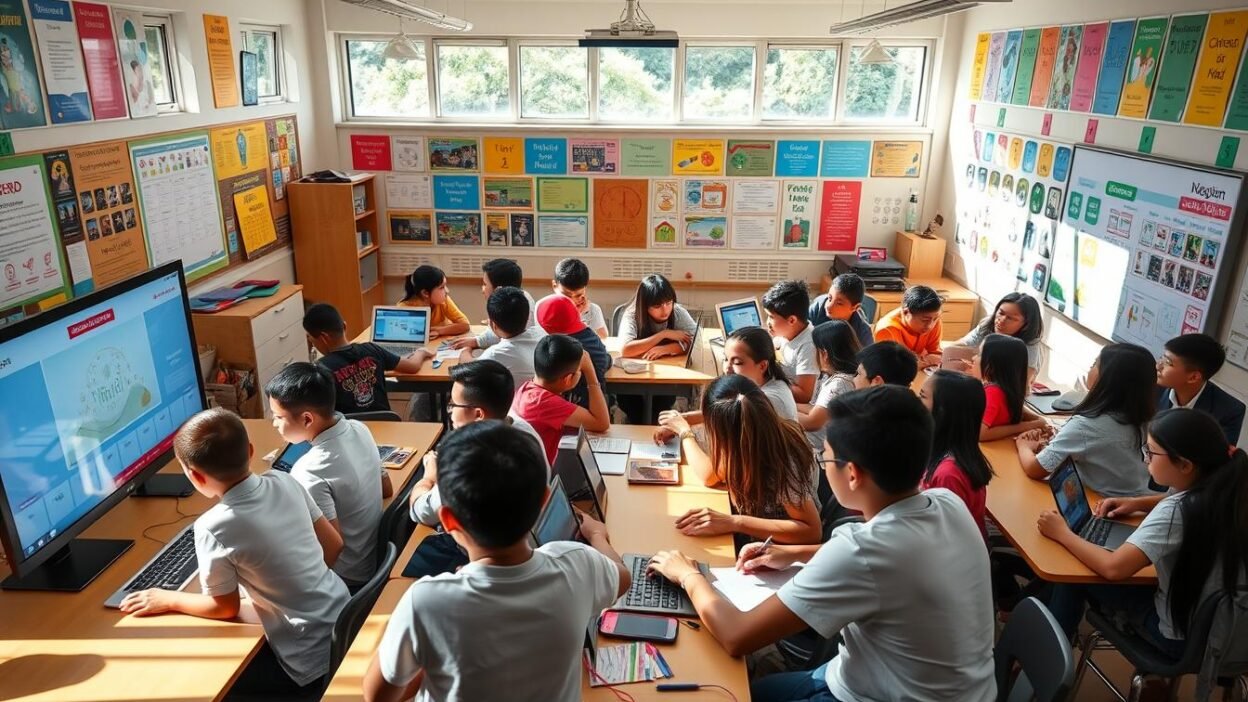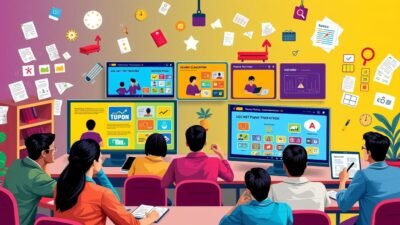Are we witnessing a revolution in education that’s hiding in plain sight? The integration of Information and Communication Technology (ICT) tools in classrooms is reshaping the educational landscape, particularly in the context of UGC NET Paper 1. These digital innovations are not just fancy gadgets; they’re powerful catalysts for change in teaching and learning processes.
As educators prepare for the UGC NET exam, understanding the role of ICT tools becomes crucial. These technologies are enhancing Teaching Aptitude by providing new ways to engage students and deliver content. From interactive whiteboards to educational apps, ICT tools are opening doors to a world of possibilities in education.
The impact of educational technology extends beyond the classroom. It’s transforming how students interact with information, collaborate with peers, and develop critical thinking skills. As we delve deeper into this topic, we’ll explore how these tools are not just changing what we teach, but how we teach and how students learn.
Key Takeaways
- ICT tools are revolutionizing teaching methods and student engagement
- Understanding ICT is crucial for UGC NET Paper 1 preparation
- Educational technology enhances Teaching Aptitude
- Digital innovations are reshaping classroom dynamics
- ICT tools foster improved collaboration and critical thinking
Introduction to UGC NET Paper 1 and Educational Technology
The UGC NET Paper 1 serves as a crucial gateway for aspiring educators and researchers in India. This comprehensive exam assesses candidates’ teaching aptitude and general awareness of the educational landscape. Research Aptitude forms a significant component of the paper, evaluating critical thinking and analytical skills essential for academic pursuits.
Overview of UGC NET Paper 1
UGC NET Paper 1 covers a wide range of topics, including:
- Teaching Aptitude
- Research Methodology
- Comprehension
- Communication
- Mathematical Reasoning and Aptitude
- Logical Reasoning
- Information and Communication Technology (ICT)
- People, Development, and Environment
- Higher Education System
Significance of Technology in Education
Educational technology has revolutionized the teaching-learning process. Digital literacy has become a vital skill for both educators and students. The integration of ICT tools in classrooms enhances engagement, promotes interactive learning, and prepares students for the digital age.
| Traditional Education | Technology-Enhanced Education |
|---|---|
| Teacher-centered approach | Student-centered learning |
| Limited resources | Access to vast online resources |
| Fixed classroom setting | Flexible learning environments |
| One-size-fits-all instruction | Personalized learning experiences |
As educational technology continues to evolve, it’s reshaping the landscape of teaching and learning. Educators must adapt to these changes to effectively prepare students for the challenges of the 21st century.
Understanding ICT Tools in Education
In today’s digital age, ICT tools have become integral to modern education. These technologies revolutionize how we teach and learn, offering new ways to engage students and enhance educational outcomes.
Defining Information and Communication Technology
Information and Communication Technology (ICT) refers to digital systems that store, retrieve, and transmit information. In education, ICT tools encompass a wide range of devices, software, and platforms designed to facilitate learning and improve communication skills.
Types of ICT Tools Used in Learning
E-learning platforms form the backbone of digital education. These online systems provide a centralized hub for course materials, assignments, and student-teacher interactions. Popular examples include:
- Learning Management Systems (LMS)
- Massive Open Online Courses (MOOCs)
- Virtual Classrooms
Educational software plays a crucial role in modern learning environments. These programs offer interactive lessons, simulations, and assessments tailored to various subjects and learning styles. Some common types include:
- Language learning apps
- Math and science simulation software
- Digital textbooks and e-readers
ICT tools also extend to hardware devices used in classrooms, such as interactive whiteboards, tablets, and virtual reality headsets. These technologies create immersive learning experiences and cater to diverse learner needs.
“ICT tools in education are not just about technology; they’re about creating new possibilities for learning and growth.”
By leveraging these diverse ICT tools, educators can create dynamic, engaging learning environments that prepare students for success in our increasingly digital world.
Impact of ICT on Teaching Strategies
ICT tools are reshaping teaching strategies in profound ways. These innovations bring new dimensions to the classroom, transforming how educators engage students and deliver content.
Enhancing Engagement and Interactivity
Interactive learning takes center stage with ICT tools. Digital whiteboards and online quizzes turn passive listeners into active participants. Students now solve problems, share ideas, and collaborate in real-time, boosting their reasoning ability and critical thinking skills.
Supporting Diverse Learning Styles
ICT caters to various learning preferences. Visual learners benefit from infographics and videos. Auditory learners can access podcasts and audio lectures. Kinesthetic learners engage with simulations and virtual labs. This diversity in teaching strategies ensures every student finds their optimal learning path.
Facilitating Personalized Learning
Personalized education is now a reality with ICT. Adaptive learning platforms tailor content to individual student needs. They track progress, identify areas for improvement, and suggest custom learning paths. This approach maximizes each student’s potential and fosters a love for learning.
| Teaching Strategy | ICT Tool | Benefit |
|---|---|---|
| Interactive Learning | Digital Whiteboards | Increased Engagement |
| Visual Learning | Infographic Makers | Better Concept Retention |
| Personalized Education | Adaptive Learning Platforms | Tailored Learning Paths |
By leveraging these ICT-driven teaching strategies, educators can create dynamic, inclusive, and effective learning environments that cater to the diverse needs of today’s students.
ICT Tools: A Boon for Educators
ICT tools have revolutionized education, offering teachers powerful ways to enhance their teaching methods. These digital resources have transformed lesson planning and delivery, making education more engaging and effective.
Streamlining Lesson Planning and Delivery
Digital tools simplify lesson planning. Teachers can create interactive presentations, design quizzes, and organize course materials efficiently. This saves time and allows for more creative lesson structures.
Educational databases provide a wealth of information for lesson content. Teachers can access up-to-date research, historical data, and scientific findings to enrich their lessons. This improves the quality and relevance of educational materials.
Access to Rich Resources and Materials
ICT tools open doors to vast digital resources. Teachers can find multimedia content, educational games, and virtual simulations to supplement their lessons. These resources cater to different learning styles and make complex topics easier to understand.
| ICT Tool | Benefits for Educators |
|---|---|
| Educational Databases | Access to research, data interpretation tools |
| Presentation Software | Interactive lesson delivery, visual aids |
| Learning Management Systems | Organized course materials, easy assignment tracking |
| Virtual Labs | Safe, cost-effective science experiments |
With these tools, educators can create more dynamic and engaging lessons. They can easily adapt their teaching methods to suit individual student needs, making learning more personalized and effective.
Student Benefits from ICT Utilization
ICT tools have revolutionized the way students learn and interact. These digital resources offer numerous advantages, enhancing the educational experience and preparing learners for the future.
Improving Learning Outcomes
ICT integration boosts student engagement and academic performance. Interactive platforms and multimedia content cater to diverse learning styles, making complex concepts more accessible. Digital literacy skills developed through ICT use are crucial for future success in academics and careers.
Fostering Collaboration Among Peers
Collaborative learning thrives with ICT tools. Online forums, shared documents, and virtual classrooms enable students to work together regardless of location. This digital collaboration cultivates teamwork, communication, and people management skills essential in today’s workforce.
| ICT Tool | Benefit | Skill Developed |
|---|---|---|
| Online Discussion Forums | Peer-to-peer learning | Critical thinking |
| Virtual Whiteboards | Real-time collaboration | Visual communication |
| Cloud-based Documents | Simultaneous editing | Teamwork |
| Video Conferencing | Remote group projects | Presentation skills |
By leveraging these ICT tools, students gain valuable experience in collaborative problem-solving and project management. These skills are increasingly sought after by employers, giving ICT-savvy graduates a competitive edge in the job market.
Challenges in Implementing ICT Tools
The integration of ICT tools in education faces significant hurdles. These challenges impact the effectiveness of digital learning and highlight the need for strategic solutions.
Technical Barriers and Infrastructure Issues
The digital divide remains a pressing concern in India’s education system. Many schools lack basic ICT infrastructure, hindering the adoption of digital learning tools. Unreliable internet connectivity and outdated hardware further compound these issues.
Rural areas often struggle with limited access to technology, creating an uneven playing field for students. This disparity in ICT resources can lead to gaps in digital literacy and skills development.
| Region | Schools with ICT Labs | Internet Connectivity |
|---|---|---|
| Urban | 68% | 75% |
| Rural | 32% | 45% |
Teacher Training and Support
Effective implementation of ICT tools requires comprehensive teacher professional development. Many educators lack the necessary skills to integrate technology into their teaching practices. This gap in digital competency can hinder the full potential of ICT in education.
Emotional intelligence plays a crucial role in addressing these challenges. Teachers need support to navigate the emotional aspects of technological change and adapt their teaching methods.
“Investing in teacher training is as important as investing in hardware and software. Without skilled educators, even the most advanced ICT tools will fail to improve learning outcomes.”
Addressing these challenges requires a multi-faceted approach. Policymakers must prioritize ICT infrastructure development and create robust teacher training programs to bridge the digital divide and enhance educational outcomes.
Future Trends in ICT and Education
The world of education is evolving rapidly with new technologies shaping how we learn and teach. Let’s explore some exciting trends that are set to transform our classrooms and learning experiences.
Emerging Technologies Shaping Learning
Artificial intelligence in education is making waves. AI-powered tools can analyze student performance and provide personalized learning paths. This technology adapts to each student’s pace, ensuring they grasp concepts fully before moving on.
Virtual reality learning is another game-changer. It creates immersive experiences that bring abstract concepts to life. Imagine studying ancient Rome by walking through its streets or learning about marine biology by diving into a virtual ocean.
Predicted Changes in Educational Environments
Adaptive learning technologies are set to revolutionize classrooms. These systems use data to adjust teaching methods in real-time, catering to diverse learning styles. This shift promotes critical thinking by challenging students at their optimal level.
| Technology | Impact on Learning | Skills Developed |
|---|---|---|
| AI in Education | Personalized learning paths | Self-paced mastery |
| Virtual Reality | Immersive experiences | Spatial awareness |
| Adaptive Learning | Real-time adjustments | Critical thinking |
As these technologies become more prevalent, our learning spaces will transform. Physical classrooms may blend with virtual environments, creating hybrid spaces that cater to both in-person and remote learners. This shift will prepare students for a future where adaptability and tech-savviness are key skills.
Best Practices for Integrating ICT in Education
Integrating Information and Communication Technology (ICT) in education requires careful planning and ongoing evaluation. Effective ICT integration strategies can enhance learning outcomes and foster Problem-Solving Skills among students.
Strategic Planning for Implementation
A well-thought-out plan is crucial for successful ICT integration. Schools should assess their current infrastructure, set clear goals, and create a timeline for implementation. This process involves:
- Identifying specific educational needs
- Selecting appropriate ICT tools
- Allocating resources for equipment and training
- Developing policies for ICT use in classrooms
Ongoing Assessment and Adaptation
Educational technology assessment is vital for ensuring the effectiveness of ICT tools. Regular evaluations help educators refine their approaches and adapt to changing needs. Key aspects of this process include:
| Assessment Area | Key Considerations |
|---|---|
| Student Performance | Tracking improvement in grades and skills |
| Teacher Feedback | Gathering insights on tool usability and effectiveness |
| Technology Efficiency | Evaluating reliability and relevance of ICT tools |
| Adaptive Learning | Assessing personalized learning outcomes |
By focusing on these best practices, educators can create a dynamic learning environment that leverages ICT to its fullest potential, promoting Problem-Solving Skills and adaptive learning experiences for students.
Conclusion: The Road Ahead for ICT in Education
ICT tools have sparked a revolution in education, reshaping how we teach and learn. These technologies are key to enhancing learning outcomes and preparing students for a digital world. As we’ve seen, they offer exciting possibilities for both educators and learners.
Final Thoughts on Enhancing Learning Outcomes
The integration of educational technology in classrooms is crucial for modern teaching aptitude. UGC NET Paper 1 recognizes this importance, highlighting how ICT tools can boost student engagement and personalize learning experiences. By embracing these tools, we can create more dynamic and effective learning environments.
Call to Action for Educators and Institutions
It’s time for educators and institutions to fully embrace the future of learning. This means not just adopting ICT tools, but also developing strategies to use them effectively. Teacher training programs should focus on building digital skills, ensuring that educators can harness the full potential of educational technology. By doing so, we can prepare our students for success in an increasingly digital world.
Read More:
https://myjrf.com/category/ugc-net-paper-2/
https://myjrf.com/category/ugc-net-paper1/
https://www.ugcnetonline.in/syllabus-new.php
https://www.ugc.gov.in/Tenders/Jobs
FAQ
What is UGC NET Paper 1?
UGC NET Paper 1 is a standardized test in India that assesses candidates’ teaching and research aptitude. It covers various topics including teaching aptitude, research methodology, communication skills, reasoning ability, and data interpretation. This exam is crucial for those aspiring to become lecturers or pursue research in Indian universities and colleges.
How are ICT tools transforming education?
ICT (Information and Communication Technology) tools are revolutionizing education by enhancing student engagement, supporting diverse learning styles, enabling personalized learning experiences, streamlining lesson planning and delivery for educators, providing access to rich digital resources, fostering collaboration among students, and improving overall learning outcomes. These tools are creating more interactive, efficient, and effective educational environments.
What are some common ICT tools used in education?
Common ICT tools in education include learning management systems (LMS), educational apps, virtual reality platforms, interactive whiteboards, online collaboration tools, e-learning platforms, educational software, and digital resources such as e-books and online databases. These tools cater to various aspects of the teaching and learning process, from content delivery to assessment and collaboration.
How do ICT tools benefit educators?
ICT tools benefit educators by streamlining lesson planning and delivery, providing access to a vast array of digital resources and materials, facilitating more effective assessment methods, enabling better communication with students and parents, and supporting professional development. These tools allow teachers to create more engaging and interactive lessons, track student progress more efficiently, and adapt their teaching strategies to individual student needs.
What challenges are faced in implementing ICT tools in education?
The main challenges in implementing ICT tools in education include technical barriers and infrastructure issues, particularly in areas with limited resources or poor internet connectivity. There’s also a need for comprehensive teacher training and ongoing support to ensure effective integration of technology in classrooms. Additionally, addressing the digital divide among students and maintaining a balance between traditional and digital learning methods pose significant challenges.
What are some emerging trends in ICT and education?
Emerging trends in ICT and education include the integration of artificial intelligence for personalized learning experiences, the use of virtual and augmented reality for immersive learning environments, adaptive learning technologies that adjust to individual student needs, blockchain for secure credentialing, and the Internet of Things (IoT) for creating smart, interactive classrooms. These technologies are expected to further transform educational practices and environments in the coming years.
How can educators effectively integrate ICT tools in their teaching?
Educators can effectively integrate ICT tools by first developing a strategic plan that aligns with curriculum goals and student needs. It’s crucial to start with proper training and familiarization with the tools. Gradual implementation, ongoing assessment of the tools’ effectiveness, and willingness to adapt and experiment are key. Educators should also focus on using ICT to enhance, not replace, traditional teaching methods, ensuring a balanced approach that maximizes learning outcomes.





